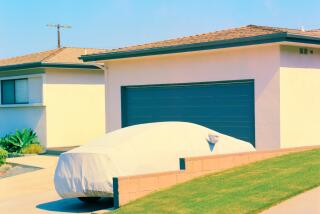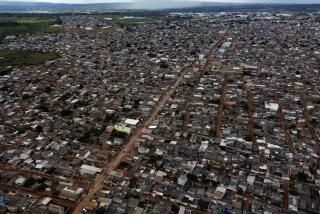Poverty Reclaims Flavio, a Brazilian Made Famous by Life Magazine
RIO DE JANEIRO, Brazil — Flavio da Silva’s smile probably saved his life.
It was his smile that caught the eye of Life magazine photographer Gordon Parks in 1961. Parks was in Rio shooting a photo essay on poverty when he spotted the sickly boy toting water in a slum.
“Death was all over him, in his chest heaving as water slopped over his bony shoulders,” Parks wrote about their meeting. “Then, jerking sideways like a mechanical toy, he smiled a smile I will never forget.”
The smile won the hearts of Americans when Flavio appeared on the cover of Life magazine’s July 21, 1961, issue, lying on hospital sheets and clutching a white stuffed dog.
“I still have that dog. And it’s clean,” Flavio says in halting but correct English.
But the smile is gone now. Jobless, living in a shed, Flavio clutches a tattered copy of his Life magazine, a fading reminder of his brief, shining moment in the sun.
“It’s hard,” he says. “Sometimes at night I lie awake in bed and scream.”
Flavio, 47, has come full circle since his childhood in Rio’s Catacumba slum, a jumble of rickety shacks set on a muddy hillside between Rio’s famous mountaintop Christ statue and a lagoon below.
Home was a 6-by 10-foot tin and wood shack with no running water or electricity, where he lived with his parents and five brothers and sisters. The slum later was razed to make a city park.
To Parks, the stunning scenery seemed to mock the misery around them. But Flavio, his 12-year-old body stunted by malnutrition and racked by acute asthma, showed a gritty realism beyond his years.
“It’s not my death I worry about, but who will take care of the others,” he told Parks.
Everything changed after the stark, black-and-white photos appeared in Life. Offers of food, clothing, money and even adoption poured in from across the United States.
The magazine received about $30,000 for the da Silvas and an offer from the Children’s Asthma Research Institute in Denver to treat Flavio free of charge.
Little more than a month after leaving, Parks was back to oversee a fairy-tale rescue. Overnight, the da Silvas had spiffy clothes and a newly furnished house on a tree-lined street in a working-class neighborhood on Rio’s outskirts.
Flavio had time only for a whirlwind tour of the new house before he was boarding what he had known only as a “silver bird,” headed for Colorado.
When his health improved, Flavio went to public school, where he learned to play baseball--a sport virtually unknown in soccer-crazy Brazil.
He spent weekends with the Goncalves family from Portugal, but their conversations soon switched from Portuguese to English as Flavio got more familiar with the language of his temporary home.
Two years later, his asthma cured, he returned to Brazil. With near perfect English and half-forgotten Portuguese, he was a virtual stranger in his own land.
“They said I had to go back to study and learn to read and write Portuguese. I didn’t want to learn Portuguese--I wanted to learn English. At that age, I could already see that this country wasn’t going anywhere,” Flavio says.
Eventually, he settled down. Flavio married, had three children and eked out a humble living as a security guard.
When Parks checked on him 15 years later, he found a hard-working family man--with an almost obsessive desire to return to the United States. Flavio believed that he was still remembered and that he still had friends who would help him make something more of himself.
Today, the obsession has faded.
He has lost contact with the Goncalveses. Phil, a friend who visited him twice in Brazil, died a few years ago.
Due to personal problems in his life, Flavio lost touch with Parks in 1987, but was recently reunited with the now 84-year-old photographer by telephone. They talked about Flavio’s family and his hard times and about the chances of getting together again.
“I’ll never forget you,” Flavio told the man who made him famous.
In 1990, Flavio separated from his wife of 18 years. He lost his job two years ago and moved back into the house bought by Life’s readers. But with a family clan of 16 now living there, Flavio was relegated to a shed in the backyard.
The house, which had a certain elegance in 1961, now is barely distinguishable from other decaying dwellings that pepper the slums, with its peeling paint, crumbling concrete and forlorn piles of cinder-blocks--the long-abandoned start of a second story.
Time and disappointment have worn deep wrinkles into Flavio’s face, but he holds little bitterness. He takes comfort from the Bible--he belongs to one of the evangelical Christian sects popular in Rio’s poor neighborhoods--and picks up the odd construction job when he can.
“At least, here we are separated from the multitudes,” Flavio says. “Look, someone who was all ready to die and now is alive through an effort that was really incredible. . . . It’s difficult to arrive at an easy conclusion about that.”
In his 1990 autobiography, “Voices in the Mirror,” Parks revealed an early premonition of how Flavio’s story would end.
Near the end of his 1961 stay in Rio, Parks treated Flavio and his brother, Mario, with a visit to Copacabana beach, which neither had ever seen although it was only about a mile from their home.
Parks wrote: “I tried pushing myself to believe that Flavio and Mario’s trip to Copacabana might give the incentive for them eventually to escape Catacumba. But I knew differently. I had only exposed them to a doubtful dream.”
Still, Parks today has few regrets.
“If I saw him tomorrow in the same conditions, I would do the whole thing over again.”
More to Read
Sign up for Essential California
The most important California stories and recommendations in your inbox every morning.
You may occasionally receive promotional content from the Los Angeles Times.










